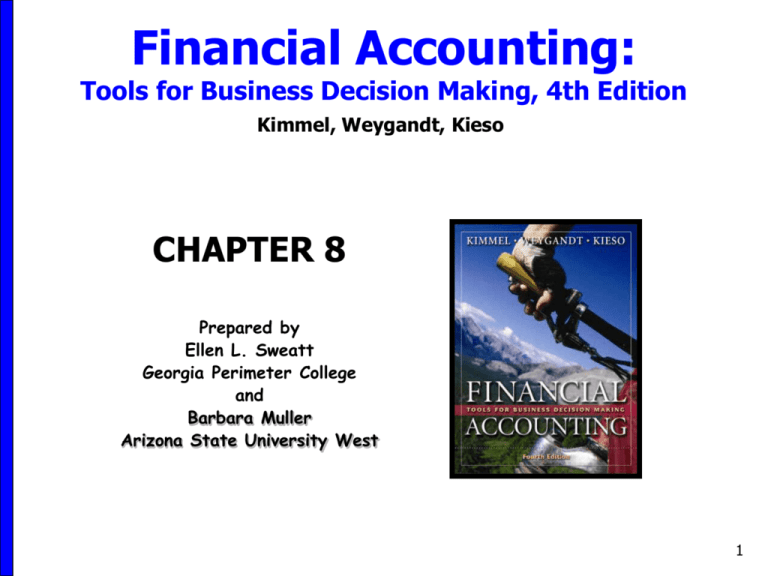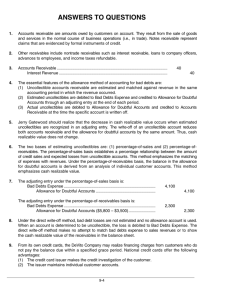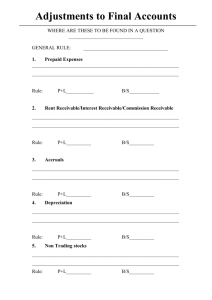
Financial Accounting:
Tools for Business Decision Making, 4th Edition
Kimmel, Weygandt, Kieso
CHAPTER 8
Prepared by
Ellen L. Sweatt
Georgia Perimeter College
and
Barbara Muller
Arizona State University West
1
Chapter 8
REPORTING AND
ANALYZING
RECEIVABLES
2
Chapter 8
Reporting and Analyzing
Receivables
After studying Chapter 8, you
should be able to:
Identify the different types of receivables.
Explain how accounts receivable are recognized in
the accounts.
Describe the methods used to account for bad
debts.
Compute the interest on notes receivable.
Describe the entries to record the disposition of
notes receivable.
3
Chapter 8
Reporting and Analyzing
Receivables
Explain the statement presentation of receivables.
Describe the principles of sound accounts
receivable management.
Identify ratios to analyze a company's receivables.
Describe methods to accelerate the receipt of cash
from receivables.
4
1
11
TYPES OF RECEIVABLES
Amounts due from individuals and other
companies-expected to be collected in cash
Three major classes of receivables
Accounts Receivable - amounts owed by customers
on account, expected to be collected within 30-60
days
Notes Receivable - claims for which formal
instruments of credit are issued
Other Receivables - non-trade receivables, for
example, interest receivable and advances to
employees
5
Receivables Differ Depending On...
Industry
Time of year
Whether the company extends long-term
financing
Credit policies
6
Accounts Receivable...
Amounts owed by customers on account.
Result from the sale of goods/services.
Expected to be collected within 30-60 days.
Most significant type of claim held by
company.
Often called trade receivables.
7
2
11
ACCOUNTS RECEIVABLE
Two accounting issues associated
with accounts receivable:
Recognizing accounts receivable.
Valuing accounts receivable.
8
RECOGNIZING ACCOUNTS
RECEIVABLE
General Journal
Date
July 1
Account Titles
Accounts Receivable – Polo Company
Sales
Debit
Credit
1,000
1,000
When a business sells merchandise to a customer on
credit, Accounts Receivable is debited (increased) and
Sales is credited (increased).
9
RECOGNIZING ACCOUNTS
RECEIVABLE
General Journal
Date
July 5
Account Titles
Sales Returns and Allowances
Accounts Receivable – Polo Company
Debit
100
Credit
100
When a business receives returned merchandise previously
When
merchandise
to a customer
on credit,
sold
to aabusiness
customersells
on credit,
Sales Returns
and Allowances
Receivable
is debited
and Sales
is credited.
isAccounts
debited and
Accounts
Receivable
is credited
(decreased).
10
Review
a.
b.
c.
d.
Accounts receivable include
Interest receivable.
Advances to employees.
Amounts customers owe from
purchasing goods and/or services.
Income taxes receivable.
11
Review
a.
b.
c.
d.
Accounts receivable include
Interest receivable.
Advances to employees.
Amounts customers owe from
purchasing goods and/or services.
Income taxes receivable.
12
3
11
ACCOUNTING FOR BAD
DEBTS
Receivables are valued at the net amount expected
to be received in cash
Excludes amounts that the company estimates it will
not be able to collect (net realizable value)
Credit losses
Recorded as Bad Debts Expense
Considered a normal and necessary risk of doing
business
13
Bad Debts Expense...
Is an expense to record estimated
uncollectible receivables.
Keeps expenses from being understated
on the income statement and accounts
receivables from being overstated on the
balance sheet.
14
2 Methods for Accounting for
Uncollectible Accounts
The Direct Write-off
Method
The Allowance Method
15
Direct Write-Off Method
Bad debt losses are not estimated.
No allowance account is used.
Accounts are written off when determined
uncollectible as follows:
Bad Debts Expense
Accounts Receivable--M. E. Doran
200
200
Bad debt expense will show only actual losses.
Accounts receivable will be reported at gross
amount.
16
DIRECT WRITE-OFF
METHOD
Direct write-off method
An entry is made for bad debts expense when an
account is determined to be uncollectible at which
time the loss is charged to Bad Debts Expense
No matching of bad debts expense with the sales
revenue
Accounts receivable are reported at their gross
amount on the balance sheet.
Not acceptable for financial reporting purposes.
17
EFFECTS OF DIRECT WRITEOFF METHOD
THE ALLOWANCE METHOD
Allowance method
Required when bad debts are deemed to be
material in amount
Uncollectible accounts are estimated
At the end of each period
Expense for the uncollectible accounts is
Matched against sales in the same
accounting period in which the sales
occurred
Results in Receivables being stated at
cash (net) realizable value
19
THE ALLOWANCE METHOD
General Journal
Date
Account Titles
Dec. 31
Bad Debts Expense
Allowance for Doubtful Accounts
Debit
Credit
12,000
12,000
Estimated uncollectibles are debited to
Bad Debts Expense and credited to
Allowance for Doubtful Accounts at the
end of each period.
20
Presentation of Allowance for
Doubtful Accounts
THE ALLOWANCE METHOD
General Journal
Date
Mar. 1
Account Titles
Allowance for Doubtful Accounts
Accounts Receivable - R. A. Ware
Debit
500
Credit
500
Actual uncollectibles are debited to Allowance for
Doubtful Accounts and credited to Accounts Receivable at
the time the specific account is written off.
General Ledger Balances after Write-off
General Ledger Balances after Write-off
Illustration 8-5
Cash Realizable Value Remains the Same!
Recovery of Uncollectible Accounts
General Journal
Date
July 1
Account Titles
Debit
Accounts Receivable – R. A. Ware
Allowance for Doubtful Accounts
500
Credit
500
When there is recovery of an account that has been written
off: reverse the entry made to write off the account and...
General Journal
Date
Account Titles
July 1
Cash
Accounts Receivable
Record the collection in the usual manner.
Debit
Credit
500
500
Allowance Method
Allowance for doubtful accounts is not
closed at the end of the year
Bad debt expense is NOT recorded when
an actual write-off occurs
•
It has been previously estimated and recorded
A write-off of accounts receivable affects
only balance sheet accounts
A recovery of accounts receivable affects
only balance sheet accounts
25
Review
a.
b.
c.
d.
The Allowance for Doubtful Accounts
represents?
Cash set aside to make up for anticipated
credit losses.
The total uncollectible accounts that arose
during the period.
The total uncollectible accounts for the period
plus estimated losses for the next period.
A contra-asset account designed to reduce
accounts receivable to net realizable value.
26
Review
a.
b.
c.
d.
The Allowance for Doubtful Accounts
represents?
Cash set aside to make up for anticipated
credit losses.
The total uncollectible accounts that arose
during the period.
The total uncollectible accounts for the period
plus estimated losses for the next period.
A contra-asset account designed to reduce
accounts receivable to net realizable value.
27
Review
a.
b.
c.
d.
The collection of a previously written off
account receivable
Results in bad debt expense being reduced for
the period.
Will impact both the income statement and
balance sheet.
Requires reversal of the entry originally made
to record the write off.
Results in bad debt expense being increased
during the period.
28
Review
a.
b.
c.
d.
The collection of a previously written off
account receivable
Results in bad debt expense being reduced for
the period.
Will impact both the income statement and
balance sheet.
Requires reversal of the entry originally made
to record the write off.
Results in bad debt expense being increased
during the period.
29
Percentage of Receivables...
Management establishes a percentage
relationship between the amount of
receivables and the expected losses
from uncollectible accounts.
2% of $600,000(credit sales) = $12,000
Aging of Accounts Receivable
The analysis of customer balances by the
length of time they have been unpaid.
The longer a debt is
outstanding
the less likely it
is to
be paid.
31
AGING SCHEDULE
The older the accounts, the less likely to be paid
PERCENTAGE OF
RECEIVABLES BASIS
If the trial balance shows Allowance for Doubtful
Accounts with a credit balance of $528, an adjusting entry
for $1,700 ($2,228 - $528) is necessary.
33
PERCENTAGE OF
RECEIVABLES BASIS
General Journal
Date
Dec. 1
Account Titles
Bad Debts Expense
Allowance for Doubtful Accounts
Debit
Credit
1,700
1,700
If the trial balance shows Allowance for Doubtful
Accounts with a credit balance of $528, an adjusting entry
for $1,700 ($2,228 - $528) is necessary.
Notes Receivable...
Credit which is extended by use of a formal
instrument.
NOTES RECEIVABLE
Promissory note
Written promise to pay a specified amount
of money on demand or at a definite time
Maker
The party making the promise.
Payee
The party to whom
payment is made.
Notes Receivable...
Credit instrument normally requires:
payment of interest
extends for time periods of 60-90 days or longer.
Give the holder a stronger legal claim than the
other receivables.
Can be sold to another party.
37
Notes Receivable...
Are often accepted from customers who
need to extend payment of an account
receivable.
Are often required
from high-risk customers.
38
4
11
FORMULA FOR COMPUTING INTEREST
The basic formula for computing interest on an
interest-bearing note is:
Face Value
of Note
X
Annual
Interest
Rate
X
Time
in Terms of
One Year
=
Interest
The interest rate specified on the note is an
annual rate of interest.
COMPUTATION OF INTEREST
Illustration 8-11
Notes Receivable...
are recorded at face
value.
are reported at cash
(net) realizable value.
are honored when
paid in full at maturity.
are dishonored when
not paid in full at
maturity.
40
RECOGNIZING NOTES
RECEIVABLE
General Journal
Date
May 1
Account Titles
Notes Receivable
Accounts Receivable – Brent Company
Debit
Credit
1,000
Wilma Company receives a $1,000, 2-month, 12%
promissory note from Brent Company to settle an open
account.
1,000
VALUING NOTES
RECEIVABLE
Like accounts receivable, shortterm notes receivable are
reported at their cash (net)
realizable value.
The notes receivable
allowance account is
Allowance for
Doubtful Accounts.
42
Review
a.
b.
c.
d.
On 1/1/07, Oscar Co. gave a $10,000,
four month, 9% note payable to Dina
Inc. At the maturity date, how much will
Dina Inc. collect from Oscar Co.?
$10,000.
$10,900. $10,000 x .09 x 120/360
$10,225.
$10,300.
43
Review
a.
b.
c.
d.
On 1/1/07, Oscar Co. gave a $10,000,
four month, 9% note payable to Dina
Inc. At the maturity date, how much will
Dina Inc. collect from Oscar Co.?
$10,000.
$10,900. $10,000 x .09 x 120/360
$10,225.
$10,300.
44
5
DISPOSING OF NOTES
RECEIVABLE
11
Notes may be held to their maturity
(honored)
Face amount plus interest is received
Notes may be sold
To speed up the collection of cash
Maker of the note may default
Note is dishonored
45
HONOR OF NOTES
RECEIVABLE
Nov 1 Cash
Notes Receivable
Interest Revenue
(To record collection of Higley
Inc. note)
10,375
10,000
375
A note is honored when it is paid in full at its maturity
date.
For an interest-bearing note, the amount due at
maturity is the face value of the note plus interest for
the length of time specified on the note.
Wolder Co. lends Higley Inc. $10,000 on June 1,
accepting a 5-month, 9% interest-bearing note.
Wolder Co. collects the maturity value of the note from
Higley on November 1.
HONOR OF NOTES
RECEIVABLE
Sept 30. Interest Receivable
Interest Revenue
(To accrue 4 months’ interest)
300
If Wolder Co. prepares prepares financial
statements as of September 30, interest for 4
months, or $300, would be accrued.
300
DISHONOR OF NOTES
RECEIVABLE
General Journal
Date
Nov 1
Account Titles
Accounts Receivable
Notes Receivable
Interest Receivable
Interest Revenue
Debit
Credit
10, 375
10, 000
300
75
A dishonored note is a note that is not paid in full
at maturity.
A dishonored note receivable is no longer
negotiable.
Since the payee still has a claim against the maker
of the note, the balance in Notes Receivable is
usually transferred to Accounts Receivable.
BALANCE SHEET PRESENTATION OF
RECEIVABLES
6
11
In the balance sheet, short-term
receivables are reported in the current
assets section below short-term
investments.
Report both the gross amount of
receivables and the allowance for
doubtful accounts.
The income statement will show
•
•
Bad debts expense
Interest revenue
49
BALANCE SHEET PRESENTATION OF
RECEIVABLES
50
7
11
MANAGING RECEIVABLES
Concentration of Credit Risk
Is a threat of nonpayment from a single customer
or class of customers that could adversely affect
the financial health of the company.
52
EVALUTING LIQUIDITY OF
RECEIVABLES
8
11
Ratios are computed to evaluate the
liquidity of a company’s accounts
receivable.
How quickly the asset can be converted to cash
Accounts receivables turnover ratio is
used to assess the liquidity of the
receivables.
Average collection period is also used to
assess liquidity
A rule of thumb is that the average collection
period should not exceed the credit term period.
53
EVALUTING LIQUIDITY OF
RECEIVABLES
54
Receivables Turnover Ratio=
Net Credit Sales
Average Net Receivables
Is a measure of the liquidity
of receivables.
55
Average Collection Period=
365 days
Receivables Turnover Ratio
Is the average amount of time that
a receivable is outstanding
56
Review
a.
b.
c.
d.
When a note receivable is dishonored by
the maker, the payee should?
Record a loss.
Establish an account receivable from the
maker.
Increase the Notes ReceivableDishonored account.
Record bad debt expense.
57
Review
a.
b.
c.
d.
When a note receivable is dishonored by
the maker, the payee should?
Record a loss.
Establish an account receivable from the
maker.
Increase the Notes ReceivableDishonored account.
Record bad debt expense.
58
ACCELERATING CASH
RECEIPTS
9
11
Companies frequently sell their
receivables to another company
to shorten their cash-to-cash
cycle
Reasons for selling receivables
•
•
•
Size of receivables, large amounts of cash are tied
up
Receivables may be the only reasonable source of
cash
Billing and collecting are time consuming and
costly
59
CREDIT CARD SALES
Credit cards
Used by retailers who wish to avoid
the paperwork of issuing credit
Cash is received quickly from the
credit card issuer
National credit cards
Visa, MasterCard, Discover, and
American Express
60
CREDIT CARDS
ADVANTAGES TO THE RETAILER
VISA, MASTERCARD, AND
DISCOVER SALES
General Journal
Date
Account Titles
Cash
Service Charge Expense
Sales
Morgan Marie purchases a
number of compact discs for
her restaurant from
Sondgeroth Music Co. for
$1,000 using her VISA First
Bank Card. The service fee
that First Bank charges is
3%.
Debit
Credit
970
30
1,000
SALE OF RECEIVABLES TO A
FACTOR
General Journal
Date
Account Titles
Cash
Service Charge Expense (2% x $600,000)
Accounts Receivable
Debit
Credit
588,000
12,000
600,000
Hendrendon Furniture factors $600,000 of
receivables to Federal Factors, Inc. Federal
Factors assesses a service charge of 2% of
the amount of receivables sold.
Review
a.
b.
c.
d.
Madeline Company’s Accounts Receivable
balance was $400,000 and the balance in the
Allowance for Doubtful Accounts was $48,000
before writing off an uncollectible account of
$60,000. What was the net realizable value of
accounts receivable after the write-off?
$352,000.
$400,000.
$292,000.
$340,000.
64
Review
a.
b.
c.
d.
Madeline Company’s Accounts Receivable
balance was $400,000 and the balance in the
Allowance for Doubtful Accounts was $48,000
before writing off an uncollectible account of
$60,000. What was the net realizable value of
accounts receivable after the write-off?
$352,000.
$400,000.
$292,000.
$340,000.
65
Evaluating the
Receivables Balance
Liquidity is measured by how quickly certain assets
can be converted into cash.
The receivables turnover ratio measures the number
of times, on average, receivables are
collected during the period.
66
Copyright © 2007 John Wiley & Sons, Inc. All rights
reserved. Reproduction or translation of this work
beyond that named in Section 117 of the United States
Copyright Act without the express written consent of the
copyright owner is unlawful. Request for further
information should be addressed to the Permissions
Department, John Wiley & Sons, Inc. The purchaser
may make back-up copies for his/her own use only and
not for distribution or resale. The Publisher assumes no
responsibility for errors, omissions, or damages, caused
by the use of these programs or from the use of the
information contained herein.
67








